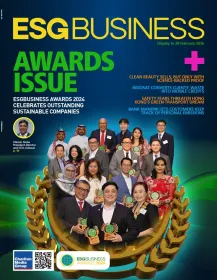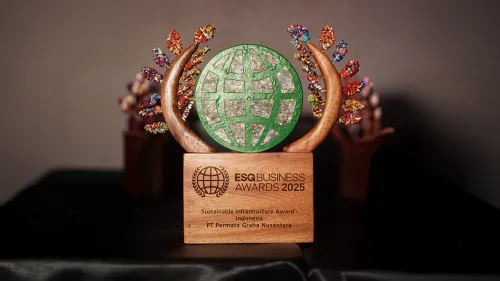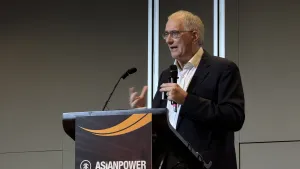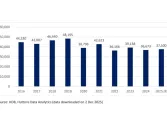
ESG succeeds through collective progression, collaboration and teamwork – EY’s Arina Kok
Kok shares how companies across Asia-Pacific are transforming environmental, social and governance (ESG) into a driver of innovation, resilience and long-term growth.
As ESG considerations take centre stage across global markets, organisations in Asia-Pacific are entering a pivotal phase of transformation. What was once perceived as a peripheral or compliance-led concern is now a strategic priority – one that underpins resilience, competitiveness, and sustainable value creation.
Arina Kok, Asia-Pacific Climate Change Advisory Leader, Asean Climate Change and Sustainability Services Co-Leader; and Partner at Ernst & Young Consulting Sdn. Bhd., brings years of experience guiding organisations to embed sustainability into their strategies, strengthening long-term performance and public trust.
With deep expertise in ESG strategy, stakeholder engagement and corporate sustainability, Kok has led key initiatives including EY’s 2020 Climate Risk Disclosure Barometer (Malaysia edition), the development of Malaysian Sustainable Finance Initiative under Capital Markets Malaysia (CMM) and the Sarawak Sustainability Blueprint 2030. She has supported the Joint Committee on Climate Change (JC3) through workshops under the UK Prosperity Fund’s ASEAN Low Carbon Energy program since 2020 and contributed to national policy dialogues with government and regulatory bodies.
As a returning judge for the ESGBusiness Awards 2025, Kok offers a comprehensive perspective on how ESG is reshaping corporate strategy, accelerating innovation and redefining success in an era of rapid change.
In your work with clients across Asia-Pacific, what fundamental shifts in mindset or strategy have you observed amongst companies that are leading in ESG integration?
We are seeing a shift in how companies across Asia-Pacific perceive ESG. What was once treated as a compliance or reputational issue is now increasingly recognised as a core lever for sustainable business value growth. As such, leading organisations are integrating ESG into business performance and corporate culture, including aspects such as strategy, capital planning and daily operations. Pacesetter companies have further transformed business models to position leading sustainable solutions or products with a clear competitive advantage.
One encouraging trend is the growing adoption of regenerative sustainability. Instead of limiting their impact, companies are aiming to create positive environmental and social outcomes as multiplier values for customers, employees and suppliers inclusively as an ecosystem. These include adopting circular product design, implementing nature-based solutions in infrastructure projects and restoring biodiversity. This reflects a broader understanding that ESG can unlock economic value, drive innovation, improve efficiency, and strengthen competitive positioning.
There is also a rise in leadership accountability. The 2024 EY Global Climate Action Barometer showed that 74% of the region’s largest companies tied ESG metrics to executive remuneration. This shift is driving action across emissions reduction, responsible sourcing and inclusive workforce practices.
Additionally, organisations are investing heavily in ESG-related upskilling. Companies, particularly in energy-intensive sectors, are training their existing workforce on competencies in energy efficiency, renewable energy, clean technology, carbon management, and corporate sustainability. Workforce capability is crucial not only for smooth project execution but also to support retention by linking skills development to a clear purpose, primarily due to the demand for an accelerated energy transition. Over 53% of large companies in Asia-Pacific have disclosed net-zero targets, up from 47% the year before. Many of these are backed by capital investments in renewable energy, low-emission technologies and energy-efficient upgrades, signalling a shift from target-setting to tangible execution.
To facilitate effective decarbonisation, companies are expanding the boundaries of ESG oversight. Scope 3 greenhouse gas (GHG) emissions reporting has increased from 50% to 63%, reflecting companies driving stronger accountability across value chains. In Malaysia, sectors like agribusiness have worked towards transparent supplier engagement, improved social safeguards and more reliable emissions data through mandated certifications. These improvements help reduce operational risks and build trust with stakeholders.
Regulation continues to play a major role. In recent years, sustainability reporting has gained strong momentum globally, catalysed by regulatory reforms, market shifts and rising stakeholder expectations. A major turning point came with the recommendations of the Task Force on Climate-related Financial Disclosures (TCFD), which introduced a structured framework for climate-related reporting. These recommendations have since evolved into global baseline standards under the International Sustainability Standards Board (ISSB). The ISSB’s IFRS S1 and S2 standards now aim to define consistent global expectations for sustainability and climate-related disclosures, which will provide decision-useful, comparable information and efficient reporting landscape.
This global momentum is mirrored across Southeast Asia, where countries are progressively aligning their domestic frameworks with ISSB Standards. The 2024 EY Global Climate Action Barometer highlighted a year-on-year improvement in both the coverage and quality of climate disclosures across the region. In Southeast Asia, the average coverage score rose from 81% in 2023 to 91% in 2024, whilst quality scores improved from 34% to 43%, indicating not only increased willingness to disclose but stronger investments in governance and reporting infrastructure. However, most are still not reflecting the physical or transition risks and opportunities in their financial statements. Neither do many communicate a plan for transitioning to a net-zero economy, with capital and operational expenditures projections still not in place – just 4% have disclosed operational expenditures and 17% have disclosed capital expenditures. These omissions reflect that most companies may be unprepared for the disruption linked to environmental, social, governance and economic that is upon us.
Markets like Singapore, Hong Kong and China have since introduced mandatory climate disclosure rules. Malaysia’s National Sustainability Reporting Framework (NSRF) requires listed companies to align with ISSB Standards. In response, companies are upgrading their ESG data systems, strengthening governance and increasingly pursuing external assurance to improve credibility of disclosures.
Together, these developments show that ESG is no longer an isolated initiative. It is becoming embedded in how leading companies define growth, manage risk and create value for stakeholders.
How are leading companies embedding ESG considerations into their innovation and product development strategies and what impact does this have on their competitiveness?
Across Asia-Pacific, ESG is increasingly viewed as a strategic lever for innovation. Leading companies are embedding sustainability principles into product development, research and development (R&D) and operational processes to stay ahead of evolving stakeholder expectations and regulatory requirements.
In the manufacturing sector, R&D teams are creating lower-emission processes and experimenting with alternative materials that reduce environmental impact whilst generating commercial value. Several companies have secured patents for these innovations, enabling access to green tax incentives and new licensing opportunities. Consumer goods companies are incorporating circular product design and switching to recycled packaging in response to extended producer responsibility requirements. These actions are reducing waste, improving supply chain resilience and building stronger alignment with shifting consumer values.
Foreign regulatory developments are also playing a catalytic role. The European Union’s (EU) Carbon Border Adjustment Mechanism (CBAM) and Deforestation Regulation (EUDR) have prompted Asia-Pacific exporters to enhance their operational practices. Manufacturers are redesigning production systems to lower embedded carbon, whilst agribusinesses are leveraging satellite monitoring and blockchain solutions to improve process, yield and establish deforestation-free supply chains. These efforts are not only helping companies retain access to international markets but also improving traceability and transparency across the value chain.
Access to capital is becoming increasingly linked to sustainability performance. In markets like Singapore and Hong Kong, ESG-aligned innovation is now a prerequisite for green grants and public procurement programmes. Financial institutions are adjusting lending terms based on ESG milestones, rewarding companies that meet metrics related to circularity, emissions reduction or inclusive product design that delivers measurable sustainability performance targets.
These trends show that companies embedding ESG into their innovation strategy are gaining a clear competitive edge. They are attracting capital, enhancing brand value and increasing investor confidence with some having reported valuation premiums. Internally, firms that align sustainability with core operations have seen stronger talent retention, especially when employees understand how their roles contribute to environmental or social outcomes. These factors are enabling businesses to remain agile, relevant and resilient in a low-carbon economy.
In what ways are data and digital tools transforming how organisations measure, manage and communicate their ESG performance?
The post-COVID-19 landscape has seen digitalisation fundamentally transform corporate approaches to reporting and disclosure, including ESG consideration. What was once a historical annual reporting, sustainability performance enabled technology is now evolving into a dynamic capability that supports risk management, performance tracking and strategic decision-making.
Cloud-based ESG platforms enable organisations to integrate sustainability data across business units and geographies. These platforms automate reporting, improve traceability and align disclosures with global frameworks. Many companies are also linking supplier data to improve emissions tracking across their value chain, which supports better visibility, influence and governance.
We have also seen a rise in artificial intelligence (AI) being applied to improve, validate and optimise emissions data, detect anomalies and extract information from large and complex datasets. Some companies are piloting digital solutions on baselining, reporting and modelling climate transition scenarios, allowing them to anticipate future risks and align capital investment with low-carbon pathways.
Real-time monitoring through Internet of Things (IoT) technology is enabling companies to track metrics, such as emissions, water use and energy consumption down to facility and asset level. In agriculture, smart irrigation systems that use weather and soil sensors have improved efficiency and resource stewardship. These applications help build trust in ESG data and instruments amongst investors and regulators whilst reducing operating costs.
Overall, these digital tools are enabling companies to move from static ESG disclosures to active management. Organisations that invest early in ESG data infrastructure are not only better prepared for tightening disclosure requirements but are more agile in adapting to evolving stakeholder expectations, talent constraints and achieving long-term sustainability goals.
How important is stakeholder engagement – including employees, customers and communities – in shaping meaningful ESG outcomes and how are companies approaching this effectively?
Stakeholder engagement is central to facilitate credibility and effective implementation of ESG strategies. Over the past few years, leading companies are starting to recognise that sustainability goals cannot be achieved in isolation. As it involves employees, customers and local communities, engagement shapes how ESG priorities are defined, implemented and sustained.
Internally, companies struggling with talent gaps are responding to employee concerns and expectations. Many professionals, especially younger talent, are seeking roles that align with their values. This has increased demand for sustainability knowledge or skills and influenced how companies shape talent development strategies. In turn, organisations that offer purpose-driven work are seeing improved employee retention and stronger internal alignment on ESG goals.
Customers are also playing a key role in accelerating ESG integration. Shifting preferences are pushing companies to redesign products and services to meet expectations around transparency, environmental impact and ethical sourcing. One regional retailer, for instance, developed a low-impact store concept featuring energy-efficient design, natural refrigerants and refill stations. These changes helped reduce emissions by 30% whilst strengthening customer loyalty and market positioning.
Engaging with communities is particularly critical in resource-intensive sectors. Companies that co-develop infrastructure and education initiatives with local stakeholders are seeing stronger relationships and reduced operational risk. This is underscored by a regional energy provider who faced constant project delays from public and community resistance. The company rebuilt relationships through community engagement, collaborative planning and decision-making, leading to more efficient permit approvals and sustained support for future developments. This is further evidenced by reporting frameworks, such as the Global Reporting Initiative (GRI) Standards and ISSB Standards, highlighting stakeholder input as crucial to identifying and prioritising material issues. Companies that actively engage stakeholders produce disclosures that are relevant, measurable and better aligned with both business and societal expectations.
Ultimately, ESG success relies heavily on collaboration. Companies that empower employees, respond to customer expectations and build trust with communities are better positioned to deliver inclusive, measurable and lasting outcomes.
Looking ahead, how do you foresee the ESG landscape in Asia-Pacific evolving in the coming years and what should companies be doing today to remain resilient and future-ready?
The ESG landscape in Asia-Pacific is entering a period of structural transformation. What was once a fragmented, voluntary initiative or limited corporate social responsibility is being driven further through regulation, capital market expectations and stakeholder demand. Companies that embed ESG into core business functions today will be better positioned to lead in a transparent, climate-conscious economy.
As evidenced by the 2023 EY Sustainable Value Study, pacesetter companies demonstrating bold climate action are 1.8 times more likely to financially outperform, reporting higher-than-expected financial value from their climate initiatives, compared to those taking the least action. Furthermore, evolving public sentiment, highlighted by a 2024 Sustainable Consumption survey by Rakuten Insight showed that 68% of Asia-Pacific consumers were willing to pay more for sustainably produced and packaged and environmentally friendly products.
By 2025, at least 13 jurisdictions across the region, including Malaysia, Singapore, Australia, Japan and Hong Kong, will require companies to disclose climate-related risks in alignment with frameworks such as the ISSB Standards. In Malaysia, regulators have introduced a phased and developmental approach that will see listed and large non-listed companies progressively align with these standards starting from end of 2025. This is pushing companies to enhance their data governance, internal capabilities and assurance readiness particularly for Scope 1 and 2 GHG emissions.
Capital markets are reinforcing this momentum. In some jurisdictions, more than 50% of recent bond issuances are tied to sustainability outcomes. Central banks, such as the Monetary Authority of Singapore and Bank Negara Malaysia are also raising expectations for climate risk scenario analysis and ESG integration within the financial system. These developments show that ESG is becoming central to how capital is assessed, priced and allocated.
At the same time, the ESG conversation is broadening. There is rising focus on nature, biodiversity, water security and social equity. The emergence of frameworks like the Taskforce on Nature-related Financial Disclosures (TNFD) is accelerating this shift. Companies that begin to understand and manage these interlinked risks and opportunities will be better aligned with emerging policy and investor expectations. Issues such as transition risk, supply chain disruption and human rights are moving from the margins into core board-level discussions. Companies that strengthen ESG governance and align sustainability with enterprise-wide risk registers are showing greater agility in responding to external pressures and market volatility.
Technology will remain a critical enabler, shifting from retrospective reporting to predictive insights that inform long-term strategy and decision-making. Advanced tools like AI, scenario modeling and integrated ESG data platforms are accelerating high-quality disclosures and real-time performance tracking. This technological evolution is poised to further embed effective ESG integration across business, operations, governance and culture.
The companies that will lead are those acting now. They are embedding ESG into capital decisions, upskilling their workforce, investing in reliable data systems and engaging with stakeholders. As regulatory, investor and societal expectations converge, these organisations will not only remain resilient but also set the pace for what responsible and competitive business looks like in Asia-Pacific.
Whilst these shifts are most visible amongst large, publicly listed companies, Malaysia is also witnessing a surge in awareness amongst small and medium enterprises (SMEs). According to Alliance Bank’s Sectoral Insights of Malaysian SMEs 2025 Report, ESG awareness amongst SMEs jumped from 14% to 80% in just two years. However, emissions tracking remains a key challenge due to technical and resource limitations. CMM introduced the Simplified ESG Disclosure Guide (SEDG) for SMEs in Supply Chains since 2023, which comprises 35 priority disclosures categorised into Basic, Intermediate and Advanced, to cater to the different levels of sustainability maturity of each SME. CMM further provides sector-specific guidelines for five priority industries and a GHG emissions calculator, which is under development, to help SMEs estimate emissions based on inputs like electricity and fuel use, empowering them to contribute meaningfully to value chain-level reporting.












